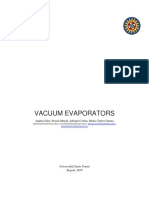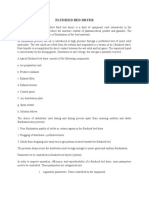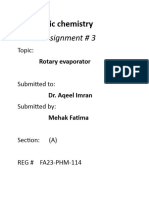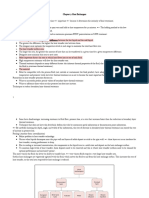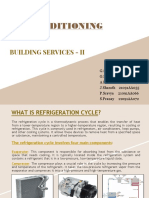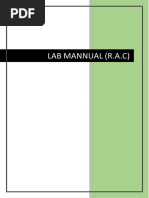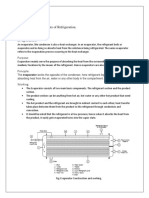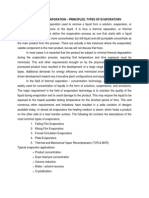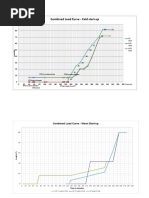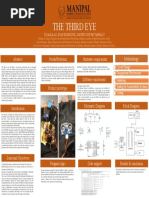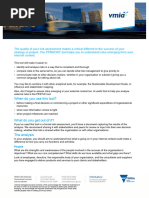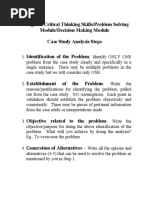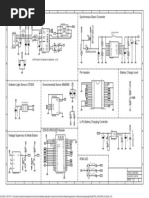MM
MM
Uploaded by
Anonymous 2trYNDKnCopyright:
Available Formats
MM
MM
Uploaded by
Anonymous 2trYNDKnOriginal Description:
Original Title
Copyright
Available Formats
Share this document
Did you find this document useful?
Is this content inappropriate?
Copyright:
Available Formats
MM
MM
Uploaded by
Anonymous 2trYNDKnCopyright:
Available Formats
Evaporator: Key Concepts and Functions
Introduction: An evaporator is a crucial component in various systems, primarily utilized in
industries such as refrigeration, air conditioning, chemical processing, and food processing.
Its primary function is to remove heat from substances, causing them to change from a liquid
state to a vapor state. Here are some key notes elucidating the workings and significance of
evaporators:
1. Principle of Operation:
Evaporators function based on the principle of heat transfer through evaporation.
They absorb heat from the substance being evaporated, causing it to vaporize.
Evaporation occurs at the surface of the liquid, where molecules with sufficient
energy break free from the liquid phase and enter the vapor phase.
2. Types of Evaporators:
Falling Film Evaporators: Liquid flows downwards as a thin film over a heated
surface, promoting rapid evaporation.
Forced Circulation Evaporators: Liquid is pumped through the evaporator,
enhancing heat transfer and preventing fouling.
Natural Circulation Evaporators: Utilize natural convection currents for liquid
circulation, suitable for low-viscosity fluids.
Plate Evaporators: Employ plates with extensive surface area for efficient heat
transfer.
Shell and Tube Evaporators: Commonly used in refrigeration systems, featuring
tubes through which a hot fluid flows to transfer heat to the substance undergoing
evaporation.
3. Applications:
Refrigeration and Air Conditioning: Evaporators are integral components in
cooling systems, where they absorb heat from the surroundings, facilitating the phase
change of refrigerants from liquid to vapor.
Food and Beverage Industry: Evaporators are employed in the concentration of
juices, milk, and other food products, removing excess water to increase their shelf
life and concentration.
Chemical Processing: Utilized in the concentration of chemical solutions, separation
of components, and recovery of solvents.
4. Factors Influencing Performance:
Temperature Difference: Higher temperature differences between the substance and
the evaporator surface enhance evaporation rates.
Surface Area: Larger surface areas promote faster evaporation by facilitating more
contact between the liquid and the heating medium.
Fluid Properties: Viscosity, density, and thermal conductivity of the fluid affect heat
transfer rates and overall efficiency.
Operating Pressure: Controlled pressure conditions can lower the boiling point of
the substance, improving evaporation efficiency.
You might also like
- Different Type of ChillersDocument7 pagesDifferent Type of ChillersMAGDY KAMEL100% (3)
- 2.1 Objective of EvaporationDocument8 pages2.1 Objective of EvaporationwakNo ratings yet
- Evaporation and its General PespectiveDocument4 pagesEvaporation and its General PespectiveWaleed AslamNo ratings yet
- Vacuum Evaporators Mateo Torres.Document11 pagesVacuum Evaporators Mateo Torres.Jakson Mateo Torres GuerraNo ratings yet
- Evaporation FullDocument57 pagesEvaporation FullMonty KushwahaNo ratings yet
- Evaporators PDFDocument25 pagesEvaporators PDFMunibah AhsanNo ratings yet
- UntitledDocument17 pagesUntitledSanjay v.r v.rNo ratings yet
- EvaporationDocument59 pagesEvaporationMonty KushwahaNo ratings yet
- Prepared By: Hussein Maytham Saied: EvaporationDocument12 pagesPrepared By: Hussein Maytham Saied: Evaporationحسين ميثم سعيد مهديNo ratings yet
- Energetics: Coffee Pharmaceutical Enzymes Kraft PulpingDocument6 pagesEnergetics: Coffee Pharmaceutical Enzymes Kraft Pulping박우진No ratings yet
- EvaporationDocument35 pagesEvaporationsodes1223No ratings yet
- Energetics: Pharmaceutical Enzymes Kraft PulpingDocument6 pagesEnergetics: Pharmaceutical Enzymes Kraft Pulping박우진No ratings yet
- Design of Wiped Film EvaporatorDocument4 pagesDesign of Wiped Film Evaporatorshirin100% (1)
- Rotary EvaporatorDocument5 pagesRotary EvaporatorMishal KhanNo ratings yet
- Evaporation and DehydrationDocument23 pagesEvaporation and DehydrationRogelyn JosolNo ratings yet
- Activity 3 - MELAB3-1Document14 pagesActivity 3 - MELAB3-1Marius ErvieNo ratings yet
- EvaporatorsDocument28 pagesEvaporatorsAbdulaziz AhmedNo ratings yet
- Hvac System & Test For Hvac QualificationDocument9 pagesHvac System & Test For Hvac Qualificationlaap85100% (1)
- Case StudyDocument8 pagesCase StudyGitesh SonarNo ratings yet
- 04 EvaporationDocument36 pages04 EvaporationPharmacistBDNo ratings yet
- EME Notes RefrigerationDocument7 pagesEME Notes RefrigerationedhanaaNo ratings yet
- EvaporatorsDocument1 pageEvaporatorsvijay kumar honnaliNo ratings yet
- Fludized Bed DryerDocument11 pagesFludized Bed DryerJubairNo ratings yet
- Evaporator: How An Evaporator WorksDocument3 pagesEvaporator: How An Evaporator WorksJames VincentNo ratings yet
- Side Stream FilterDocument5 pagesSide Stream FilterThạch ThayNo ratings yet
- Refrigeration and Air ConditioningDocument10 pagesRefrigeration and Air Conditioningumr5171No ratings yet
- HeheheDocument28 pagesHeheheQaswar aliNo ratings yet
- Organic Chemistry Lab 3Document11 pagesOrganic Chemistry Lab 3Muhammad AbdullahNo ratings yet
- Hvac 4Document6 pagesHvac 4emumerr69No ratings yet
- Evaporator and Its TypesDocument22 pagesEvaporator and Its TypesIrfan ShafiqNo ratings yet
- Evapn NotesDocument12 pagesEvapn NotesShubham bangarNo ratings yet
- Dairy and Food EngineeringDocument45 pagesDairy and Food EngineeringMouryakanth Reddy GangireddyNo ratings yet
- Food Engineering 2Document37 pagesFood Engineering 2Bảo ĐoànNo ratings yet
- Upload: Login SignupDocument16 pagesUpload: Login SignupSeid AragawNo ratings yet
- Air Conditioning - Building ServiceDocument12 pagesAir Conditioning - Building ServiceHarini Andal AgnihotramNo ratings yet
- DryingDocument8 pagesDryingAjaya Kumar MohapatraNo ratings yet
- HvacDocument5 pagesHvacmenhNo ratings yet
- Manufacturing Tecnology of CompressorDocument27 pagesManufacturing Tecnology of Compressorapi-3858545100% (6)
- Energetics: Solvents Desalination Zero Liquid Discharge Drinking WaterDocument6 pagesEnergetics: Solvents Desalination Zero Liquid Discharge Drinking Water박우진No ratings yet
- Lecture Notes On DryingdsgaaaaaaaaaaDocument15 pagesLecture Notes On DryingdsgaaaaaaaaaaSaumith DahagamNo ratings yet
- The Applications of Heat Exchangers Refrigeration SystemsDocument38 pagesThe Applications of Heat Exchangers Refrigeration SystemsBasem RajabNo ratings yet
- EvaporationDocument14 pagesEvaporationSudarshan BorkarNo ratings yet
- Desiccant Wheel Dehumidification 2Document19 pagesDesiccant Wheel Dehumidification 2ovidiu73No ratings yet
- Evaporation EvaporatorsDocument11 pagesEvaporation EvaporatorsOhad CazesNo ratings yet
- Rac Lab MannualDocument24 pagesRac Lab MannualRAZA ULLAHNo ratings yet
- Refrigeration and Air Conditiong Lab MannualDocument24 pagesRefrigeration and Air Conditiong Lab MannualCreative 360No ratings yet
- FFEDocument8 pagesFFEsarthak vyavhareNo ratings yet
- Assignment Refrigeration ComponentDocument4 pagesAssignment Refrigeration ComponentVishal DulangeNo ratings yet
- EVAPORATIONDocument17 pagesEVAPORATIONdestig123No ratings yet
- Chapter 21: Evaporation - Principles, Types of EvaporatorsDocument7 pagesChapter 21: Evaporation - Principles, Types of EvaporatorssdfaNo ratings yet
- Milk Factory Visit ReportDocument10 pagesMilk Factory Visit ReportshubhamrasalNo ratings yet
- MultipleDocument13 pagesMultipleNİSA AYDINNo ratings yet
- EVAPORATORDocument3 pagesEVAPORATORIris CruzNo ratings yet
- Spray Drying Applications: Pharmaceuticals Ethanol Nitrogen Atomizer Spray NozzleDocument4 pagesSpray Drying Applications: Pharmaceuticals Ethanol Nitrogen Atomizer Spray NozzlejorgeNo ratings yet
- Evaporator HistoryDocument7 pagesEvaporator History박우진No ratings yet
- Refrigeration and Air Conditioning 2Document11 pagesRefrigeration and Air Conditioning 2Varad KhedkarNo ratings yet
- Mefc113 Module 1Document32 pagesMefc113 Module 1NELMIDA AIRISH JOY N.No ratings yet
- Process Engineering: Facts, Fiction and FablesFrom EverandProcess Engineering: Facts, Fiction and FablesRating: 3 out of 5 stars3/5 (2)
- Salalah II IPP Combined Cycle Start Up CurveDocument3 pagesSalalah II IPP Combined Cycle Start Up CurveAnonymous 2trYNDKnNo ratings yet
- PAKSHIDocument5 pagesPAKSHIAnonymous 2trYNDKn100% (1)
- TMR Control of Steam Turbine at Kuttalam CCPPDocument2 pagesTMR Control of Steam Turbine at Kuttalam CCPPAnonymous 2trYNDKnNo ratings yet
- 1.1 Purpose of The ReportDocument14 pages1.1 Purpose of The ReportAnonymous 2trYNDKnNo ratings yet
- Third Eye PosterDocument1 pageThird Eye PosterZulaika AliNo ratings yet
- MVC Chapter 6Document24 pagesMVC Chapter 6AziziphoNo ratings yet
- Electro Cardiograf Edan SE 1201 PDFDocument173 pagesElectro Cardiograf Edan SE 1201 PDFIoan Octavian Stanciu100% (1)
- 2SD 2335 - IscDocument3 pages2SD 2335 - IscStevenNo ratings yet
- My Future Innovation: Name: Syifa Rista Nur Alfia Class: 12 AccountingDocument5 pagesMy Future Innovation: Name: Syifa Rista Nur Alfia Class: 12 AccountingSyifa RistaNo ratings yet
- Tda 9351Document118 pagesTda 9351HellzingNo ratings yet
- Bushing CT PDFDocument4 pagesBushing CT PDFgloby_pnbNo ratings yet
- 3123-Article Text-15021-1-10-20191028Document11 pages3123-Article Text-15021-1-10-20191028Naman Thakur 20bee037No ratings yet
- Low-Voltage Circuit Breakers: Types of Circuit Breakers, Their Features and FunctionsDocument32 pagesLow-Voltage Circuit Breakers: Types of Circuit Breakers, Their Features and FunctionsArjun DasNo ratings yet
- Chapter Wise Physics 9Document9 pagesChapter Wise Physics 9RAI SHAHZAIB MUMTAZNo ratings yet
- The Language of Psychology: APA Style As EpistemologyDocument9 pagesThe Language of Psychology: APA Style As EpistemologyMafalda Lourenço SantosNo ratings yet
- PMCFDocument9 pagesPMCFAnalyn Etang GabunilasNo ratings yet
- Fatima - Case AnalysisDocument8 pagesFatima - Case Analysisapi-307983833No ratings yet
- L55 Owners ManualDocument112 pagesL55 Owners ManualTerry_Matthews_1324No ratings yet
- Joseph Campbell's Mythology - The Twin Flame Metaphor - Angel Number Twin FlameDocument31 pagesJoseph Campbell's Mythology - The Twin Flame Metaphor - Angel Number Twin Flameyuwabin369No ratings yet
- Question & Answer Data WaerhousingDocument2 pagesQuestion & Answer Data Waerhousingdevya123No ratings yet
- ReikaDocument2 pagesReikaapi-316785824No ratings yet
- PPRACKIFDocument2 pagesPPRACKIFJeevan JyotiNo ratings yet
- Project Report: Aim:-TheoryDocument6 pagesProject Report: Aim:-TheoryHarsh MendaparaNo ratings yet
- Introduction To ProgramminDocument5 pagesIntroduction To ProgramminSuleiman MaiwadaNo ratings yet
- Bma Handbook of MathematicsDocument2 pagesBma Handbook of Mathematicspenumudi23325% (4)
- Owners: White Cement Concrete and Colored Concrete ConstructionDocument4 pagesOwners: White Cement Concrete and Colored Concrete ConstructionsonofalexanderNo ratings yet
- ZN StainingDocument30 pagesZN Stainingmbvenkatesh14No ratings yet
- Electric Machine ch03Document16 pagesElectric Machine ch03api-302761543No ratings yet
- 9 Steps of Problem Solving Module - DetailedDocument3 pages9 Steps of Problem Solving Module - DetailedDeepanshu VarshneyNo ratings yet
- A Journal HatinaDocument15 pagesA Journal HatinaSyukur ZiliwuNo ratings yet
- Commissioning Procedure of 6KV Switchgear (Approved)Document154 pagesCommissioning Procedure of 6KV Switchgear (Approved)Karthikeyan S100% (1)
- Esp32 WroverDocument1 pageEsp32 WroverIonicaNo ratings yet
- BilledStatements 3091 11-06-24 13.03Document3 pagesBilledStatements 3091 11-06-24 13.03iiiotvijayNo ratings yet
- Machiavelli PowerpointDocument11 pagesMachiavelli Powerpointapi-26948035483% (6)



